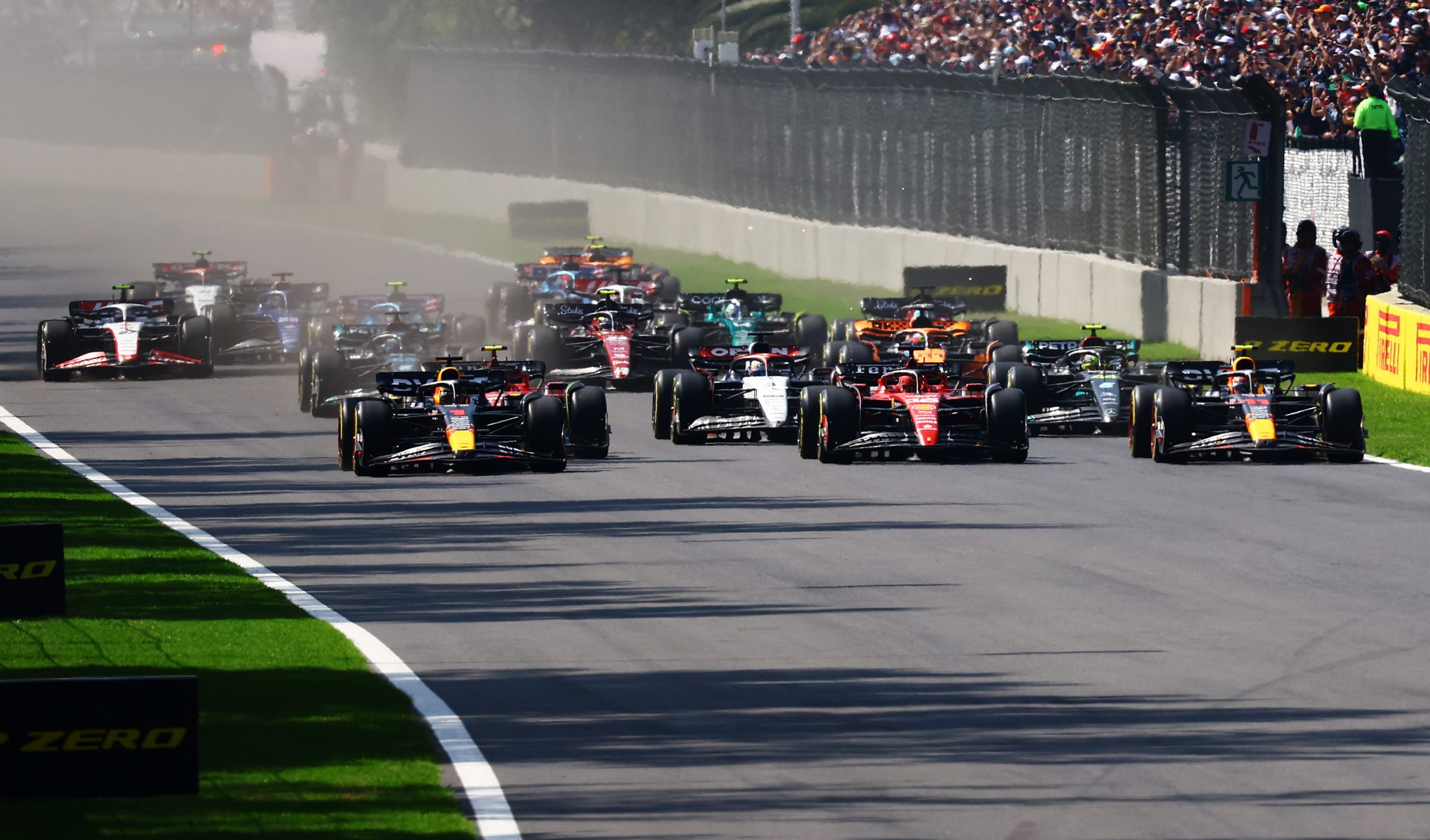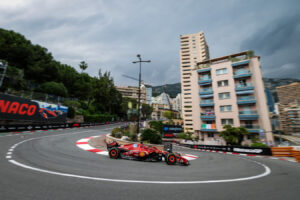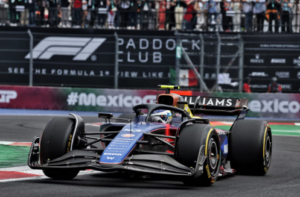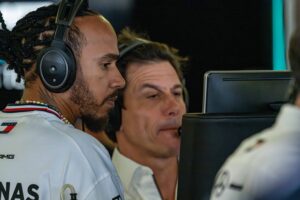Before we head for the third round of another triple-header let’s take a look at the Mexican Grand Prix strategies.
Formula 1 is headed into another race weekend. Before we dwell on that let’s analyze the strategies used at the Mexican Grand Prix.
Strategy: What Pirelli said
The Autodromo Hermanos Rodriguez is one of the highest circuits on the F1 calendar. It sits over two kilometers above sea level. Lower air pressure and less air affect the car’s performance. The change in altitude impacts engine power, cooling, and downforce, to name a few. The track is shorter with a long main straight, and typically, in this layout, teams would gravitate towards a low downforce car. The altitude, though, pushes the teams to have more downforce to gain speed, as fans see at Monza. However, the wings used in Mexico are more significant than the ones used in Italy.
For the Mexican Grand Prix Pirelli nominated the C3 (hard tyre), C4 (medium tyre), and C5 (soft tyre). These are the softest compounds in their range, last seen in Singapore in September. After two consecutive weekends with the Sprint format, in Qatar and Austin, the teams reverted to normal in Mexico. This means they were given 13 sets of tyres instead of 11. These include two sets of hard, three sets of mediums, and eight sets of soft. In addition, they had the green intermediate tyre and the blue full wets, if required.
Throughout the weekend the teams had in their favor the stable weather. Apart from the unexpected light rain in FP2 the rest of the sessions played out in sunny conditions. So the temperatures remained in between 20-25 C. The forecast for the race was more or less the same, with a warm and sunny day expected with a high of 26C. However, it was sunny enough that the teams were wary of getting stuck in traffic due to overheating issues.
Strategy options
This is one of the toughest venues to pass on. That’s because of the altitude and the cooling impact that it has on cars, as they don’t get the same amount of airflow through the various inlets due to the air density. So overheating is already an issue before you factor in the traffic. After the Free-Practice sessions, this led the teams towards trying to make a one-stop strategy.
Starting with the medium compound could have provided the balance between grip off the line for the extremely long run down to Turn 1. In addition, the rubber could have had enough longevity to reach the first lap window between Lap 27 to 34. From there the teams would have likely opted for the hard rubber till the end of the race.
The pit stops were expected to happen in the earlier stage of that window. This is in order to protect from undercut threat and retain track position. However, this means that a little bit of tyre management would have been required. Moreover, degradation levels had been relatively low up until the Free Practice Sessions. This means that all three compounds had a good tyre life.
Top 10 vs. Bottom half
For the top 10, there could have been a more aggressive approach. For those who found themselves stuck in traffic after the opening stint, a two-stop strategy could have come into play. After an opening stint on mediums, an earlier pitstop between Lap 17 and Lap 23 to take on hard tyres. This could open up the opportunity to gain track position through an undercut. The second pitstop should have been made between Lap 45 to Lap 51 and then have a final stint that would have required overtaking. This is a potential route for the teams and drivers who retained two sets of medium tyres for the race. This group includes Ferrari, Mercedes, McLaren, and Haas, as well as Sergio Perez and Yuki Tsunoda.
Instead, for the bottom half of the field even for those who had targeted the same one-stop all three compounds could have come into play. As always, this was permitted if degradation levels were higher than expected, or they had made the decision to make an earlier pit stop to try and gain clean air. Starting on mediums but then making the first pitstop between Lap 17 and Lap 23 to take on hards would have mirrored the two-stop strategy above. For those who didn’t have a second set of medium, the stop would have been an option for the final stint. In this case, the driver would have needed to get to at least the mid-50s in terms of laps before making the extra pit stop.
Race day
On race day, the Mexican Grand Prix saw a very interesting turn of events. Kevin Magnussen’s Lap 34 crash meant that all drivers could change their tyres for free without making any more pit stops. Thirty-six laps was a comfortable distance within the range of the hard rubber. On the other hand, the medium’s quicker warm-up could have seen it significantly faster for at least the first five laps. However, the pattern was different from car to car. Some teams had the hard down as the fastest tyre over a stint making up in its slower degradation what it lost in the first few laps to its slower warm-up. Others had the medium as faster but only if you could control the wear.
In the end, the situation was different for each team. Verstappen already had used his only set of mediums and had only just put his second new set of hards a lap before the red flag. Ferrari, instead, had a choice. Leclerc and Sainz each had a set of used mediums available. However, the hards they had just fitted before the red flag still had plenty of life in them. In addition, Ferrari’s numbers suggested that the hard would have been the faster tyre over a stint, because of their high tyre degradation.
Mercedes’ numbers were different, as was its situation. Hamilton would have been restarting third, in between Charles Leclerc and Carlos Sainz. George Russell would have restarted in seventh place. Moreover, their numbers suggested that the medium was actually faster over a stint if the wear could be controlled.
Bet on hards
As both Hamilton and Russell had pitted several laps earlier, Mercedes decided to fit both cars with the mediums. McLaren’s thinking was similar to that of the Silver Arrows. After the Safety Car (brought out by Magnussen’s crash), Norris was asked if he thought the hard would be okay for a restart, he then said yes because “There’s just too far to go for the mediums.” However, he was overruled and fitted with a one-lap old set of mediums. Oscar Piastri was fitted with a slightly old set of the same.
Hamilton took advantage of Leclerc’s tyres that still had to come up to temperature. As Leclerc slotted in third Hamilton made his getaway off the grid. The Mercedes was not fast enough on the straights to challenge the Ferrari without DRS, which was enabled after two laps. However, even with the DRS Hamilton was not significantly faster than the Ferrari without it. On the fifth lap after the restart, Hamilton got closer to Leclerc and subsequently overtook him as the Monégasque tried to fend him off.
Russell didn’t have the same success as Hamilton. Initially, he’d been pressuring Carlos Sainz for fourth place, but as he faced the same straight-line speed problem as his teammate, he fell back. His tyres cooled off as they suffered quite a high wear. After he slowed down to control his brake caliper temperatures it was impossible to get the rubber up to temperature again. Instead, Norris was having none of that. He charged through the pack on his mediums from 14th place, where he had fallen to at the restart. Five laps from the end, he overtook Russell and was closing down on Sainz fast as the checkered flag fell.
Verstappen hadn’t spared a thought for his tyres once he’d led the restart. He had a sufficient margin that he could probably have won with any tyre combination. It was a luxury that the others didn’t have.






